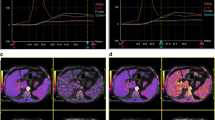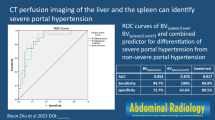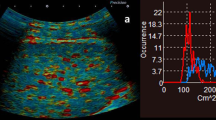Abstract
Objective
The objective was to examine the effect of splenic circulation using a microbubble agent to assess the severity of portal hypertension.
Methods
This prospective study consisted of 91 subjects (63.0 ± 12.6 years, 30–86; 60 males, 31 females), 62 cirrhosis and 29 controls, who underwent both Doppler ultrasound and contrast-enhanced ultrasound with a perflubutane microbubble agent. Two microbubble-based parameters for splenic circulation, the minimum circulation time (MCT, s) and the peak enhancement time (PET, s), were assessed with respect to the hepatic venous pressure gradient (HVPG) and other clinical findings.
Results
The MCT and PET showed significant differences between cirrhosis (5.7 ± 1.8; 14.6 ± 3.0) and controls (4.0 ± 1.9, p < 0.0001; 8.9 ± 2.3, p < 0.0001), respectively. However, only PET offered positive correlations with wedged hepatic venous pressure (r = 0.4648, p = 0.0001) and HVPG (r = 0.4573, p = 0.0001). The area under the receiver operating characteristics curve to identify HVPG ≥ 10 mmHg, and 12 mmHg was 0.76 and 0.76, respectively.
Conclusions
The microbubble-based non-invasive assessment of the splenic circulation is effective to identify the severity of portal hypretension presumably by reflecting congestion of splenic venous flow due to increased portal venous pressure.
Key Points
• There is a potential link between splenic circulation and portal hypertension.
• Microbubble-based assessment of splenic circulation is predictive of the severity of portal hypertension.
• Interobserver variability was sufficient in the assessment of splenic enhancement sonograms.





Similar content being viewed by others
Abbreviations
- CT:
-
Computed tomography
- HVPG:
-
Hepatic venous pressure gradients
- MCT:
-
Minimum circulation time
- PET:
-
Peak enhancement time
- PI:
-
Pulsatility index
- RI:
-
Resistive index
- SD:
-
Standard deviation
- WHVP:
-
Wedged hepatic venous pressure
References
Sanyal AJ, Bosch J, Blei A, Arroyo V (2008) Portal hypertension and its complications. Gastroenterology 134:1715–1728
de Franchis R, Dell’Era A, Primignani M (2008) Diagnosis and monitoring of portal hypertension. Dig Liver Dis 40:312–317
D’Amico G, Garcia-Pagan JC, Luca A, Bosch J (2006) Hepatic vein pressure gradient reduction and prevention of variceal bleeding in cirrhosis: a systematic review. Gastroenterology 131:1611–1624
Ripoll C, Groszmann R, Garcia-Tsao G et al (2007) Hepatic venous pressure gradient predicts clinical decompensation in patients with compensated cirrhosis. Gastroenterology 133:481–488
Abraldes JG, Villanueva C, Banares R et al (2008) Hepatic venous pressure gradient and prognosis in patients with acute variceal bleeding treated with pharmacologic and endoscopic therapy. J Hepatol 48:229–236
Thabut D, Moreau R, Lebrec D (2011) Noninvasive assessment of portal hypertension in patients with cirrhosis. Hepatology 53:683–694
Castera L, Pinzani M, Bosch J (2012) Non invasive evaluation of portal hypertension using transient elastography. J Hepatol 56:696–703
Talwalkar JA, Yin M, Venkatesh S et al (2009) Feasibility of in vivo MR elastographic splenic stiffness measurements in the assessment of portal hypertension. AJR Am J Roentgenol 193:122–127
Berzigotti A, Seijo S, Arena U et al (2013) Elastography, Spleen size, and platelet count identify portal hypertension in patients with compensated cirrhosis. Gastroenterology 144:102–111
Bolognesi M, Sacerdoti D, Merkel C et al (1996) Splenic Doppler impedance indices: influence of different portal hemodynamic conditions. Hepatology 23:1035–1040
Vizzutti F, Arena U, Rega L et al (2007) Performance of Doppler ultrasound in the prediction of severe portal hypertension in hepatitis C virus-related chronic liver disease. Liver Int 27:1379–1388
Piscaglia F, Donati G, Cecilioni L et al (2002) Influence of the spleen on portal haemodynamics: a non-invasive study with Doppler ultrasound in chronic liver disease and haematological disorders. Scand J Gastroenterol 37:1220–1227
Choi YJ, Baik SK, Park DH et al (2003) Comparison of Doppler ultrasonography and the hepatic venous pressure gradient in assessing portal hypertension in liver cirrhosis. J Gastroenterol Hepatol 18:424–429
Berzigotti A, Gilabert R, Abraldes JG et al (2008) Noninvasive prediction of clinically significant portal hypertension and esophageal varices in patients with compensated liver cirrhosis. Am J Gastroenterol 103:1159–1167
Bosch J, Abraldes JG, Berzigotti A, García-Pagan JC (2009) The clinical use of HVPG measurements in chronic liver disease. Nat Rev Gastroenterol Hepatol 6:573–582
Moriyasu F, Itoh K (2009) Efficacy of perflubutane microbubble-enhanced ultrasound in the characterization and detection of focal liver lesions: phase 3 multicenter clinical trial. AJR Am J Roentgenol 193:86–95
Monescillo A, Martinez-Lagares F, Ruiz-del-Arbol L et al (2004) Influence of portal hypertension and its early decompression by TIPS placement on the outcome of variceal bleeding. Hepatology 40:793–801
Vorobioff J, Groszmann RH, Picabea E, Gamen M, Villavicencio R, Bordato J et al (1996) Prognostic value of hepatic venous pressure gradient measurements in alcoholic cirrhosis: a 10-year prospective study. Gastroenterology 111:701–709
Casado M, Bosch J, Garcia-Pagan JC, Bru C, Banares R, Bandi JC et al (1998) Clinical events after transjugular intrahepatic portosystemic shunt: correlation with hemodynamic findings. Gastroenterology 114:1296–1303
Groszmann RJ, Bosch J, Grace ND et al (1990) Hemodynamic events in a prospective randomized trial of propranolol versus placebo in the prevention of a first variceal hemorrhage. Gastroenterology 99:1401–1407
Schmidt EE, MacDonald IC, Groom AC (1993) Comparative aspects of splenic microcirculatory pathways in mammals: the region bordering the white pulp. Scanning Microsc 7:613–628
Cesta MF (2006) Normal structure, function, and histology of the spleen. Toxicol Pathol 34:455–465
Groom AC, MacDonald IC, Schmidt EE (2002) Splenic microcirculatory blood flow and function with respect to red blood cells. In: Bowdler AJ (ed) The complete spleen: structure, function, and clinical disorders. Humana Pres, New Jersey, pp 23–50
Colecchia A, Montrone L, Scaioli E et al (2012) Measurement of spleen stiffness to evaluate portal hypertension and the presence of esophageal varices in patients with HCV-related cirrhosis. Gastroenterology 143:646–654
Sharma P, Kirnake V, Tyagi P et al (2013) Spleen stiffness in patients with cirrhosis in predicting esophageal varices. Am J Gastroenterol 108:1101–1107
Ronot M, Lambert S, Elkrief L et al (2014) Assessment of portal hypertension and high-risk oesophageal varices with liver and spleen three-dimensional multifrequency MR elastography in liver cirrhosis. Eur Radiol 24:1394–1402
Kaufman S, Levasseur J (2003) Effect of portal hypertension on splenic blood flow, intrasplenic extravasation and systemic blood pressure. Am J Physiol Regul Integr Comp Physiol 284:R1580–R1585
Hamza SM, Kaufman S (2009) Role of spleen in integrated control of splanchnic vascular tone: physiology and pathophysiology. Can J Physiol Pharmacol 87:1–7
Merkel C, Bolognesi M, Sacerdoti D et al (2000) The hemodynamic response to medical treatment of portal hypertension as a predictor of clinical effectiveness in the primary prophylaxis of variceal bleeding in cirrhosis. Hepatology 32:930–934
Turnes J, Garcia-Pagan JC, Abraldes JG, Hernandez-Guerra M, Dell’Era A, Bosch J (2006) Pharmacological reduction of portal pressure and long-term risk of first variceal bleeding in patients with cirrhosis. Am J Gastroenterol 101:506–512
La Mura V, Abraldes JG, Raffa S et al (2009) Prognostic value of acute hemodynamic response to i.v. propranolol in patients with cirrhosis and portal hypertension. J Hepatol 51:279–287
de-Madaria E, Palazon JM, Hernandez FT et al (2010) Acute and chronic hemodynamic changes after propranolol in patients with cirrhosis under primary and secondary prophylaxis of variceal bleeding: a pilot study. Eur J Gastroenterol Hepatol 22:507–512
Bolognesi M, Sacerdoti D, Merkel C, Bombonato G, Enzo E, Gatta A (1997) Effects of chronic therapy with nadolol on portal hemodynamics and on splanchnic impedance indices using Doppler sonography: comparison between acute and chronic effects. J Hepatol 26:305–311
Okuda K, Kono K, Ohnishi K et al (1984) Clinical study of eighty-six cases of idiopathic portal hypertension and comparison with cirrhosis with splenomegaly. Gastroenterology 86:600–610
Acknowledgments
The scientific guarantor of this publication is Hitoshi Maruyama. The authors of this manuscript declare no relationships with any companies, whose products or services may be related to the subject matter of the article. The authors state that this work has not received any funding. No complex statistical methods were necessary for this paper. Institutional Review Board approval was obtained. Written informed consent was obtained from all subjects (patients) in this study. Methodology: prospective, diagnostic or prognostic study, performed at one institution.
Author information
Authors and Affiliations
Corresponding author
Rights and permissions
About this article
Cite this article
Shimada, T., Maruyama, H., Kondo, T. et al. Impact of splenic circulation: non-invasive microbubble-based assessment of portal hemodynamics. Eur Radiol 25, 812–820 (2015). https://doi.org/10.1007/s00330-014-3476-3
Received:
Revised:
Accepted:
Published:
Issue Date:
DOI: https://doi.org/10.1007/s00330-014-3476-3




